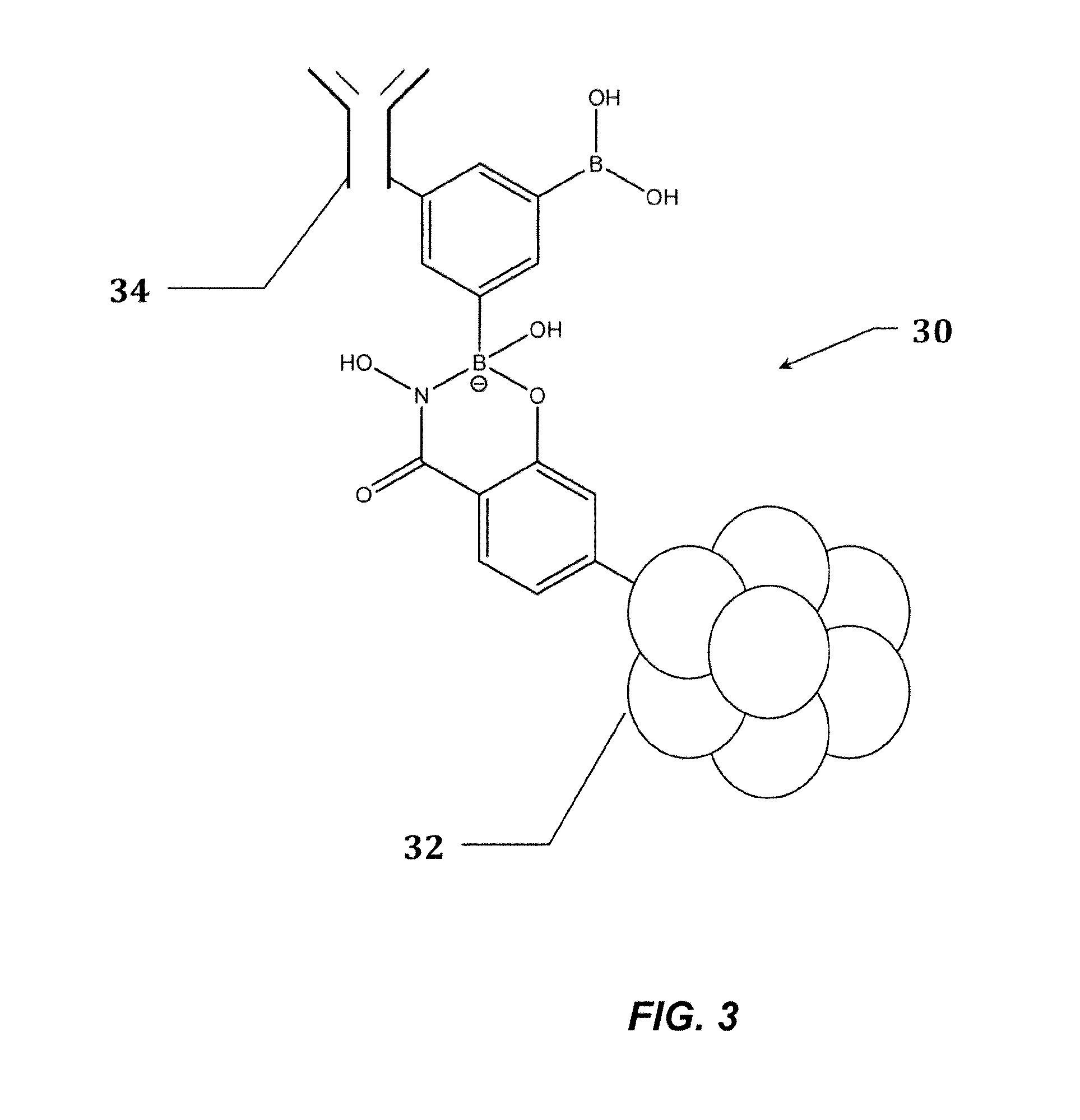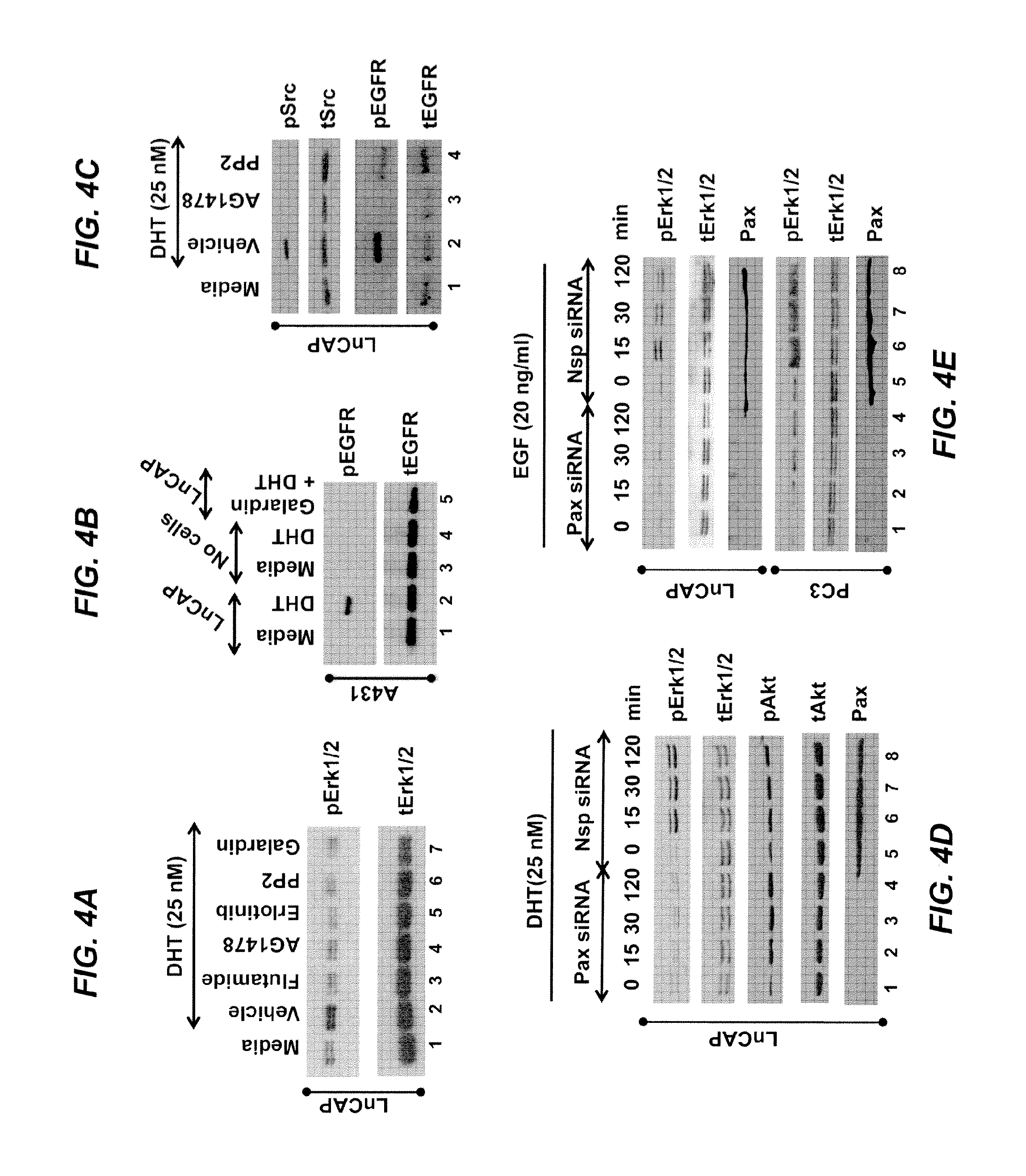Paxillin as a therapeutic or diagnostic marker for cancer
- Summary
- Abstract
- Description
- Claims
- Application Information
AI Technical Summary
Benefits of technology
Problems solved by technology
Method used
Image
Examples
example 1
DHT-Induced Erk Signaling Occurs Via Matrix Metalloproteinase (MMP)-Mediated Transactivation of the EGF Receptor
[0126]Because androgens induce Erk1 / 2 signaling in PCa cell lines (Migliaccio et al., “Crosstalk Between EGFR and Extranuclear Steroid Receptors,”Ann. N.Y. Acad. Sci. 1089:194-200 (2006); Peterziel et al., “Rapid Signaling by Androgen Receptor in Prostate Cancer Cells,”Oncogene 18(46):6322-6329 (1999); Migliaccio et al., “Steroid-Induced Androgen Receptor-Oestradiol Receptor Beta-Src Complex Triggers Prostate Cancer Cell Proliferation,”EMBO J. 19(20):5406-5417 (2000), which are hereby incorporated by reference in their entirety) the underlying mechanism by which DHT activates Erk1 / 2 in LnCAP cells was examined. DHT treatment of LnCAP cells for 30 minutes significantly induced Erk1 / 2 phosphorylation / activation (FIG. 4A, lane 2). Notably, saturating concentrations of DHT (25 nM) were used in these studies to max-imize the significance of the inhibitor effects; however, lower...
example 2
Paxillin Regulates DHT- and EGF-Induced ERK Activation in Prostate Cancer Cells
[0129]Next it was investigated whether paxillin regulated Erk1 / 2 activation in prostate cancer cells. In androgen-dependent LnCAP cells, both DHT (FIG. 4D) and EGF (FIG. 4E) induced Erk1 / 2 activation from 15 to 120 minutes. Knockdown of paxillin abrogated DHT-induced Erk1 / 2 activation, but not Akt activation (FIG. 4D). Furthermore, paxillin knockdown in either LnCAP or androgen-independent PC3 cells inhibited EGF-induced Erk1 / 2 activation (FIG. 4E) but not Akt activation. Similar effects were observed in DHT-treated LAPC-4 prostate cancer cells and FGF- or EGF-treated HEK-293 cells (FIG. 11A). These observations indicate that paxillin is an important regulator of growth factor receptor-induced Erk1 / 2 signaling regardless of cell type or how the growth factor receptor is activated (EGFR either indirectly by DHT or directly by EGF, or FGFR directly by FGF). Furthermore, EGF-mediated Erk activation was atten...
example 3
Paxillin Acts Downstream of the EGF Receptor but Upstream of Raf / MEK
[0130]To investigate where paxillin functions in EGF receptor-induced signaling, DHT- or EGF-induced activation of MEK and EGFR in paxillin-ablated LnCAP cells was examined. Similar to Erk1 / 2 activation, knockdown of paxillin markedly lowered DHT- (FIG. 5A) and EGF-induced MEK1 / 2 phosphorylation. Furthermore, loss of DHT-induced Erk1 / 2 activation by paxillin knockdown could be rescued by overexpression of constitutively activated MEK (caMEK; FIG. 5B, lanes 7 and 8) or Raf (caRaf; FIG. 5C, lanes 7 and 8). The caMEK used has mutations substituting glutamic and aspartic acid for Ser-218 and Ser-222, significantly increasing the basal activity of MEK over the unphosphorylated wild-type enzyme (Robinson et al., “Contributions of the Mitogen-Activated Protein (MAP) Kinase Backbone and Phosphorylation Loop to MEK Specificity,”J. Biol. Chem. 271:29734-29739 (1996); Mansour et al., “Transformation of Mammalian Cells by Const...
PUM
| Property | Measurement | Unit |
|---|---|---|
| Time | aaaaa | aaaaa |
| Composition | aaaaa | aaaaa |
| Surface | aaaaa | aaaaa |
Abstract
Description
Claims
Application Information
 Login to View More
Login to View More - R&D
- Intellectual Property
- Life Sciences
- Materials
- Tech Scout
- Unparalleled Data Quality
- Higher Quality Content
- 60% Fewer Hallucinations
Browse by: Latest US Patents, China's latest patents, Technical Efficacy Thesaurus, Application Domain, Technology Topic, Popular Technical Reports.
© 2025 PatSnap. All rights reserved.Legal|Privacy policy|Modern Slavery Act Transparency Statement|Sitemap|About US| Contact US: help@patsnap.com



